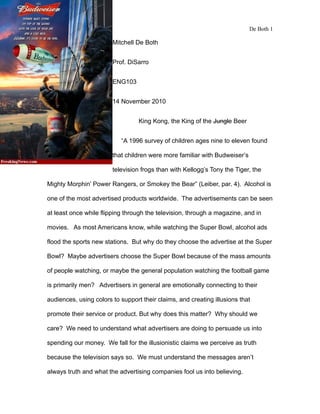
Rhetorical Analysis (Final Draft)
- 1. De Both 1 Mitchell De Both Prof. DiSarro ENG103 14 November 2010 King Kong, the King of the Jungle Beer “A 1996 survey of children ages nine to eleven found that children were more familiar with Budweiser’s television frogs than with Kellogg’s Tony the Tiger, the Mighty Morphin’ Power Rangers, or Smokey the Bear” (Leiber, par. 4). Alcohol is one of the most advertised products worldwide. The advertisements can be seen at least once while flipping through the television, through a magazine, and in movies. As most Americans know, while watching the Super Bowl, alcohol ads flood the sports new stations. But why do they choose the advertise at the Super Bowl? Maybe advertisers choose the Super Bowl because of the mass amounts of people watching, or maybe the general population watching the football game is primarily men? Advertisers in general are emotionally connecting to their audiences, using colors to support their claims, and creating illusions that promote their service or product. But why does this matter? Why should we care? We need to understand what advertisers are doing to persuade us into spending our money. We fall for the illusionistic claims we perceive as truth because the television says so. We must understand the messages aren’t always truth and what the advertising companies fool us into believing.
- 2. De Both 2 As we take a look at the supplied Budweiser advertisement, what do your eyes make their first connection with, maybe the text, the blimp, or the giant gorilla known as King Kong? Whatever it may be, it has a message and strategic placing. When taking a glance at the picture, King Kong is holding a beautiful woman in a majestic setting (what I find humorous is that the creator decided not to put the planes shooting hundreds of bullets at the massive gorilla). The gorilla is a sign of power and strength, the primitive man. The text tidbit, "Nothing beats sitting on top of the world with the love of your life and a cold beer… AAAhhh, it's good to
- 3. De Both 3 be the king," supports the visual and clearly states what the beer companies want the viewer to think. Drink this beer and be strong, the king, have the love of a lifetime. The setting in the background further aids in creating the illusion the advertisers want the intended audience to fall for. Or maybe the red can and blimp stick out most. Red brings text and images to the foreground. The color red is also a color of passion, sexuality, power, and courage (QSX Software, par. 3). The use of colors in advertising has psychological effects on the audience to help pull out certain emotions. Pulling out the emotions mentioned previously seems perfect for the type of advertisement. King Kong is a gigantic, strong, feared fictional character, portrayed in this advertisement as a “man”. Not the man in today’s day and age, busy with a desk job and whatnot. He is the primitive man who is strong, ruthless, and in Budweiser’s depiction, drinks beer. The advertisement has that message saying drink our beer, and become more like King Kong. Sure it sounds silly, but that’s the message being implied. When analyzing this image in context of the rhetorical triangle, King Kong is looking pretty weak. The text can be viewed as a weak logos appeal because the statement is claiming to be true, but there is no logical sense to it. No way am I persuaded to believe that if I drink Budweiser beer I’ll become successful, strong, and happy in life. It might not seem quite logical, but the idea has been put out there. Budweiser is using its famous name to help it’s credibility. Being able to locate the name of the “King of Beer” three times throughout the advertisement pushes it’s credibility forward. It’s almost as if Budweiser is saying to you, “Hey, trust me. We’re Budweiser, would we lie?” Not only do they use
- 4. De Both 4 Budweiser three times but it’s also written in blue which symbolizes trustworthiness and honesty. Maybe the emotional appeal, or pathos, captivates some viewers. The beautiful sunset, the city skyline, the woman, they all can convince the audience to say, "Hey that looks like a good time". The movie “King Kong” came out in the year 2005. During that time I was a freshman in high school and it was extremely popular amongst my friends. Now when I find an advertisement like this, it makes me wonder. Is there a connection between using the movie “King Kong” and it’s audience who finds it most appealing to Budweiser Beer? And the movie “King Kong” is generally more appealing to young adults and teenagers. Again, why does this matter? Advertisers are using subjects popular to young adults and teenagers to sell their product. They are targeting an age group that is most susceptible to alcohol use. There was a considerable amount of thought put behind this Budweiser advertisement. Such as the use of colors, why use the giant ape known as King Kong, the brute holding onto a beautiful woman. All these concepts are used by advertisers to sell a product, and to a specific age group. By use of the rhetorical triangle, advertisers can fully express their messages in the most intelligent, emotional, and credible ways. Next time an advertisement passes by, take a look. Look for a deeper meaning, look at all the details. There’s more to the advertisement than what is seen in a first glance.
- 5. De Both 5 Works Cited Diffen. Blue Color Vs Red Color. N.p., 23 August 2006. Web. 11 November 2010. Leiber, L. Commercial and Character Slogan Recall by Children Aged Nine to 11 Years. Berkeley, CA: Center on Alcohol Advertising, 1996. QSX Software. Color Wheel Pro. QSX Software, n.d. Web. 22 Oct. 2010. Soren. Inspirational Quotes. N.p., 19 June 2007. Web. 22 Oct. 2010.